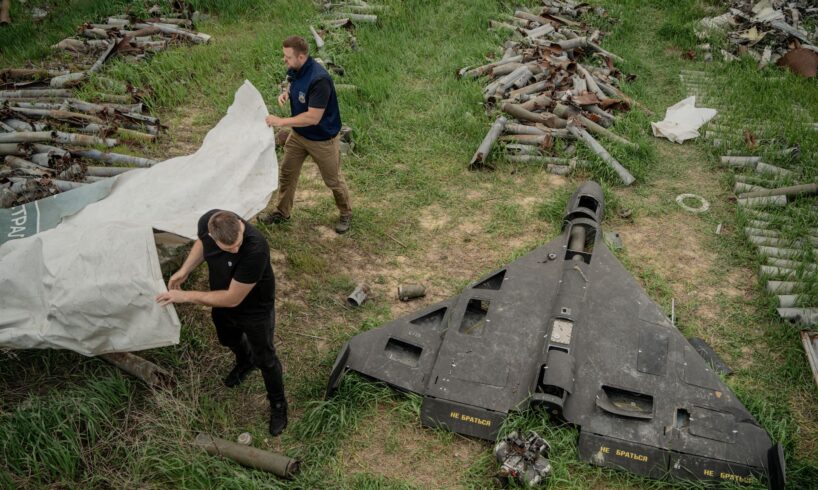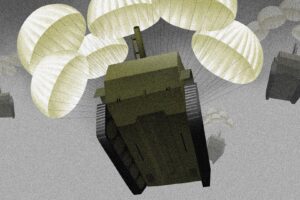
Russia has repeatedly shattered its own records for aerial assaults on Ukraine this summer, culminating in a peak attack on July 9 with the launch of 728 Shahed-type drones.
Throughout the war, Russia steadily expanded the reach and intensity of its strikes on Ukrainian cities, drawing on drone technology primarily supplied by its ally Iran. Russia first deployed Iranian-made Shahed-131 and Shahed-136 drones against Ukraine in 2022.
By the next year, Russia had moved to produce its own, modified versions — the Geran-1 and Geran-2 — modeled on Iranian designs.
Often painted black to make them less visible at night, Gerans can cover about 2,500 kilometers (1,554 miles) and reach speeds of up to 180 kilometers per hour (112 miles per hour), mirroring the performance and design of its Iranian counterpart, according to Ukraine’s military intelligence.
Since incorporating Iranian technology to produce low-cost drones, priced up to $80,000, according to the D.C.-based Center for Strategic and International Studies, Russia has introduced numerous modifications to make them more destructive in attacks on Ukraine.
Federico Borsari, a fellow at the D.C.-based Center for European Policy Analysis (CEPA), said the navigation system has been one of the major upgrades to the Geran drones.
Early versions used a four-array controlled reception pattern antenna with a global navigation satellite systems (CRPA GNSS) setup, but as Ukrainian electronic warfare became more effective, Russia shifted to more resilient systems, outfitting newer models with 8- or even 16-array Kometa CRPA GNSS units or, in some cases, cheaper Chinese-made alternatives.
Some drones are also equipped with radio transmitters for remote control or 3G/LTE modem modules that connect to local cellular networks, enhancing navigation redundancy and allowing for telemetry and video transmission, Borsari added.
An exhibition of downed Russian drones containing imported components in Kyiv, Ukraine, on June 27, 2025. (Kyrylo Chubotin / Ukrinform/NurPhoto via Getty Images)
Newer versions of the Geran drones carry more destructive warheads, boosted from 40–50 kg to 80–90 kg. They can also include a flammable, viscous substance that causes severe incendiary effects upon detonation, according to the expert.
Ongoing drone modifications aside, Russia’s attacks are strikingly devastating due to sheer volume as well, boosted further by the use of decoy UAVs.
Multifunctional decoy drones
In 2024, Russia began widely using a new tactic of overwhelming Ukrainian air defenses with long-range decoy drones, specifically the Parodya and Gerbera models.
Decoy drones cost up to ten times less than the Geran, around $10,000, according to the D.C.-based Institute for Science and International Security (ISIS). It is typically built from cheap foam plastic and plywood, weighing less than 20 kilograms. Its range is also shorter — up to 600 kilometers (372 miles), according to Ukraine’s military intelligence.
Jacob Parakilas, research leader in RAND Europe’s Defense, Security, and Justice Research Group in Cambridge, called the Gerbera an effective decoy because it is a cheaper and simpler drone that flies along similar routes and produces similar electronic and radar signatures as an attack drone.
“They come from different directions and at varying altitudes — from ultra-low to higher elevations — attacking from multiple angles, which, of course, makes the job of air defense much more difficult.”
“It forces Ukrainian defenders to expend resources tracking and engaging it, thereby giving the Shahed-type drones and other missiles a better chance of reaching their own targets,” Parakilas told the Kyiv Independent.
Soldiers of the 115th brigade fire at drones in the Lyman area, Donetsk Oblast, Ukraine, April 24, 2025. (Jose Colon/Anadolu via Getty Images)
Many decoy drones are equipped for reconnaissance and can even carry small warheads, but their primary purpose is still to saturate and confuse Ukrainian air defenses. That strategy was on full display on July 4, when Russia launched over 550 aerial weapons, including 330 kamikaze drones, at Ukraine.
“They come from different directions and at varying altitudes — from ultra-low to higher elevations — attacking from multiple angles, which, of course, makes the job of air defense much more difficult,” Ukraine’s Air Force spokesperson Yurii Ihnat said on national television.
Despite shooting down 270 aerial threats and jamming 208 more with electronic warfare, the Russian attack still killed three people and injured 32 others, including a 10-year-old girl, in Kyiv, which was the strike’s primary target.
What’s next in Russia’s arsenal against Ukraine?
The drone threat to Ukraine could soon intensify as Russia ramps up production at its main manufacturing hubs in Yelabuga and Izhevsk, with further capacity still untapped, experts told the Kyiv Independent.
Russia now produces more than 5,000 long-range drones each month — roughly split between Shahed-type strike drones and decoy models.
As of May 2025, monthly output included approximately 2,700 Geran strike drones and 2,500 Gerbera decoys, marking nearly a fivefold increase since the summer of 2024, Forbes Ukraine reported, citing Ukraine’s military intelligence.
A Russian military truck transports Geran-2 drones across Red Square during a Victory Day parade in Moscow, Russia, on May 9, 2025. (Kirill Kudryavtsev / AFP via Getty Images)A large plume of smoke rises from a fire after a mass drone and missile attack by Russia on the capital on July 4, 2025, in Kyiv, Ukraine. (Kostiantyn Liberov / Libkos / Getty Images)
Experts interviewed by the Kyiv Independent said Russia’s production surge has been fueled by a steady supply of dual-use goods from China, confirmed earlier by Ukrainian intelligence, as well as the use of labor from North Korea and African countries.
According to a February report from Ukraine’s military intelligence service, Russia was already developing the Geran 3 model, which would enhance speed by replacing piston engines with jet-powered ones.
Military expert Parakilas said the drone could also be upgraded with more durable electronics and two-way data links, enabling operators to respond in real time and engage moving targets, among other improvements.
But Parakilas noted that such upgrades would come at a steep cost, a point echoed by Israel-based defense analyst David Sharp.
“There is a certain bottleneck in the improvement. Theoretically, you can improve the Geran a lot, but then it will be an expensive drone,” Sharp told the Kyiv Independent. “It will affect the mass production and cost.”
Sharp noted that the current pace of Russian drone production, both attack and decoy, appears to have already outstripped the Kremlin’s original plans. Still, the expert is skeptical that Moscow is willing to spend “wild” money on drones originally designed to be cheap to produce.
“I expect we’ll see widespread use of decoy drones and smaller systems designed to strike closer-range targets,” he told the Kyiv Independent.
“Scaling is the key issue. But these predictions that Russia will soon be producing 1,000 Shahed-type drones and launching them across Ukraine in a day… In my view, those numbers just are not realistic right now.”
Note from the author:
Hi, this is Kateryna, the author of this article. Thanks for reading. Living in Ukraine, my loved ones and I know firsthand what it means to be targeted by Russian drones. We’ve spent countless nights listening to explosions and the haunting buzz of engines circling above, growing louder as they approach, then fading — only to return again.
If you want the world to truly understand the scale of Russia’s crimes, consider joining our community today to help support our work.
As Russia closes in on Pokrovsk, battle for key city enters its final act
Editor’s Note: In accordance with the security protocols of the Ukrainian military, soldiers featured in this story are identified by first names and callsigns only. POKROVSK, Donetsk Oblast – Light rain and the dying light of a cool summer evening accompany the Ukrainian drone team’s preparation to begin their shift. The men are silent as the military pick-up truck, full of drones and other supplies, turns off the village track onto the main road south into Pokrovsk. Every trip in and out of





